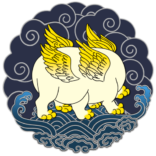For the year of 壬寅 Yang Water Tiger, Wind-Wood Qi is excess in general. Shaoyang Ministerial Fire governs the first half of the year, while Jueyin Wind-Wood governs the second half of the year. We are entering the last quarter of the Last Qi phase of this year. There are 24 season nodes in each Lunar year. At a first glance, it may seem peculiar that the 23rd season node (Minor Cold) is deemed as the last season of the year instead of the 24th (Major Cold), because the time when Yang Qi initially generated should be the beginning of each Lunar year, which is the season node of 立春 Establishment of Spring. However, it is a fundamental Daoist belief that the initial spark of Yang (warmth, movements, etc.) is brewed within the extreme Yin (coldness, stillness, etc.). The 24th season is the coldest season of the year, and it is the time when the initial signs of Yang first appear above the ground, even though we do not feel anything until the next season.
Currently, the Host Qi is Taiyang Cold Water, and the Guest Qi is Jueyin Wind Wood. Jueyin Wind-Wood Qi tends to make things drier, and generate a lot of wind, which drains and exhausts the Taiyang energies. People with underlying Cold or Wind pathogens tend to have recurring symptoms in this season, such as allergies, autoimmune responses, inflammation, etc. People also tend to develop leaking diseases, heart pain, cough due to unanchored Yang. Progression of diseases tends to be rapid this year due to the nature of Guest Qi, Jue Yin. This pathological pattern is manifested mostly in China, where almost everyone has contracted the COVID. It is predicted that this situation will become better in spring.
Appropriate treatment should focus on regulating the Guest Qi Jueyin — tonify it with pungent flavor, drain it with sour flavor, and moderate it with sweet flavor. It is beneficial to mainly ingest bearded grains (wheat, oat, barley, etc.) in this season, and supplement with rice to expel Wind pathogens. Warming method is also appropriate for this season.
According to 「月令」 “The Monthly Orders,” 物候 the seasonal material manifestations of 小寒 Minor Cold are:
初候 The 1st Qi phase: 雁北向 Swan geese Head North;
二候 The 2nd Qi phase: 鵲始巢 Magpies Begin Nest-Building;
三候 The 3rd Qi phase: 雉始雊 Ring-necked Pheasants Begin to Crow.
Anadromous birds such as swan geese are the animals most sensitive to atmospheric changes. Light in the atmosphere changes first as the day becomes longer in the Northern hemisphere, then heat from the sun slowly and gradually accumulates in the soil and water in the following months. Swan geese are in the South near the Yangzi River floodplain at this time of the year, and they begin to head North when the lights begin to shift.
Non-migratory birds like magpies would need to build stronger and thicker nests to protect themselves from the upcoming cold weather in the season of Major Cold. So this is a symbol that the northern regions are still very frozen and only becoming colder.
The ring-necked pheasants are called “wild chickens” in Chinese, perhaps because they behave like roosters, who resonate with Yang Qi of the earth and crow at daybreak (the time when Yang first rises). The reason that ring-necked pheasants are selected to symbolize this Qi phase may be because they have a bright red fleshy patch of skin around the eye. Head is considered the center of all of the Yang Qi in the body, and the red skin patch in the head may be a symbol of abundant Yang Qi in these birds.
All of the symbols of this season node are represented by birds, which are Fire animals (feathered animals are considered Fire creatures). Fire is the very representative phase of Yang Qi. So even if the weather keeps getting colder in the Northern hemisphere, as the sun has started moving North, Yang has begun to advance.
Please find the recipe for this season on my substack.

